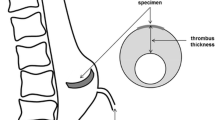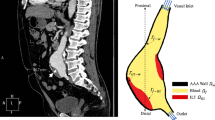Abstract
The abdominal aortic aneurysm (AAA) is a degenerating disease for which the end stage is the rupture of the vessel wall. Accurate prediction of the stresses acting on the aneurysm tissue may be used to determine the actual risk of rupture of a specific aneurysm. To accomplish this, a correct constitutive model for the aneurysmal aortic wall and any intraluminal thrombus (ILT) present within it are needed. Our laboratory has previously reported the mechanical properties of ILT. The aim of this work is to investigate the reliability of using population-mean values of ILT constitutive parameters to estimate AAA wall stress distribution. For this, a three-dimensional asymmetric model of an aneurysm including ILT was generated and a parametric study was conducted varying ILT constitutive properties within a physiological range. Results show that the presence of any ILT reduces and redistributes the stresses in the aortic wall markedly. Maximum variation in the peak wall stresses for all the models analyzed was 5%. Adopting a nonhomogeneous ILT did not alter the stress distribution. On the basis of these results, we infer that population mean parameters for ILT material characteristics can be used to reasonably estimate the wall stresses in patient specific aneurysm models. © 2003 Biomedical Engineering Society.
PAC2003: 8719Rr, 8719Xx, 8710+e
Similar content being viewed by others
References
Adolph, R., D. A. Vorp, D. L. Steed, M. W. Webster, M. V. Kameneva, and S. C. Watkins. Cellular content and permeability of intraluminal thrombus in abdominal aortic aneurysm. J. Vasc. Surg.5:916–926, 1997.
Di Martino, E. S., G. Guadagni, A. Fumero, G. Ballerini, R. Spirito, P. Biglioli, and A. Redaelli. Fluid-structure interaction within realistic three-dimensional models of the aneurysmatic aorta as a guidance to assess the risk of rupture of the aneurysm. Med. Eng. Phys.23:647–655, 2001.
Di Martino, E., S. Mantero, F. Inzoli, G. Melissano, D. Astore, R. Chiesa, and R. Fumero. Biomechanics of abdominal aortic aneurysm in the presence of endoluminal thrombus. Eur. J. Vasc. Endovasc Surg.15:290–299, 1998.
Elger, D. F., D. M. Blackketter, R. S. Budwig, and K. H. Johansen. The influence of shape on the stresses in model abdominal aortic aneurysms. J. Biomech. Eng.118:326–332, 1996.
Harter, L. P., B. H. Gross, P. W. Callen, and R. A. Barth. Ultrasonic evaluation of abdominal aortic thrombus. J. Ultrasound Med.1:315–318, 1982.
Inzoli, F., F. Boschetti, M. Zappa, T. Longo, and R. Fumero. Biomechanical factors in abdominal aortic aneurysm rupture. Eur. J. Vasc. Surg.7:667–674, 1993.
Katz, D. A., B. Littenberg, and J. L. Cronenwett. Management of small abdominal aortic aneurysms. Early surgery vs. watchful waiting. J. Am. Med. Assoc.268:2678–2686, 1992.
Mower, W. R., W. J. Quinones, and S. S. Gambhir. Effect of intraluminal thrombus on abdominal aortic aneurysm wall stress. J. Vasc. Surg.26:602–608, 1997.
Newman, A. B., A. M. Arnold, G. L. Burke, D. H. O'Leary, and T. A. Manolio. Cardiovascular disease and mortality in older adults with small abdominal aortic aneurysms detected by ultrasonography. Ann. Intern Med.134:182–190, 2001.
Raghavan, M. L., and D. A. Vorp. Toward a biomechanical tool to evaluate rupture potential of abdominal aortic aneurysm: Identification of a finite strain constitutive model and evaluation of its applicability. J. Biomech.33:475–482, 2000.
Raghavan, M. L., D. A. Vorp, M. P. Federle, M. S. Makaroun, and M. W. Webster. Wall stress distribution on three dimensionally reconstructed models of human abdominal aortic aneurysm. J. Vasc. Surg.31:760–769, 2000.
Raghavan, M. L.and D. A. Vorp. Toward a biomechanical tool to evaluate rupture potential of abdominal aortic aneurysm: Identification of a finite strain constitutive model and evaluation of its applicability. J. Biomech.33:475–482, 2000.
Schurink, G. W. H., J. M. van Baalen, J. M. T. Visser, and J. van Bockel. Thrombus within an aortic aneurysm does not reduce pressure on the aneurismal wall. J. Vasc. Surg.31:501–506, 2000.
Scott, R. A., H. A. Ashton, and M. J. Lamparelli. Vascular surgical society of Great Britain and Ireland: Fifteen years of experience using 6 cm as a criterion for abdominal aortic aneurysm surgery. Br. J. Surg.86:709–710, 1999.
Smith, D. B., M. S. Sacks, D. A. Vorp, and M. Thorton. Surface geometric analysis of anatomic structures using biquintic finite element interpolation. Ann. Biomed. Eng.28:598–611, 2000.
Stringfellow, M. M., P. F. Lawrence, and R. G. Stringfellow. The influence of aorta-aneurysm geometry upon stress in the aneurysm wall. J. Surg. Res.42:425–433, 1987.
Thubrikar, M. J., F. Robicsek, M. Labrosse, V. Chervenkoff, and B. L. Fowler. Effect of thrombus in AAA on pressure and dilation experienced by the aneurysm wall. In: ASME-IMECE Proceedings,New York, 2001.
Vorp, D. A., W. A. Mandarino, M. W. Webster, and J. Gorcsan, II. Potential influence of intraluminal thrombus on abdominal aortic aneurysm as assessed by a new non-invasive method. Cardiovasc. Surg.4:732–739, 1996.
Vorp, D. A., M. L. Raghavan, and M. W. Webster. Mechanical wall stress in abdominal aortic aneurysm: influence of diameter and asymmetry. J. Vasc. Surg.27:632–639, 1998.
Wang, D. H. J., M. S. Makaroun, M. W. Webster, and D. A. Vorp. Mechanical properties and microstructure of intraluminal thrombus from abdominal aortic aneurysm. J. Biomech. Eng.123:536–539, 2001.
Wang, D. H. J., M. S. Makaroun, M. W. Webster, and D. A. Vorp. Effect of intraluminal thrombus on stress distribution in patient specific models of abdominal aortic aneurysm. J. Vasc. Surg.36:598–604, 2002.
Wang, D. H. J., M. S. Makaroun, and D. A. Vorp. Noninvasive estimation of wall strength distribution in human abdominal aortic aneurysm. In: ASME-IMECE Proceedings, New York, 2001.
Author information
Authors and Affiliations
Rights and permissions
About this article
Cite this article
Di Martino, E.S., Vorp, D.A. Effect of Variation in Intraluminal Thrombus Constitutive Properties on Abdominal Aortic Aneurysm Wall Stress. Annals of Biomedical Engineering 31, 804–809 (2003). https://doi.org/10.1114/1.1581880
Issue Date:
DOI: https://doi.org/10.1114/1.1581880




